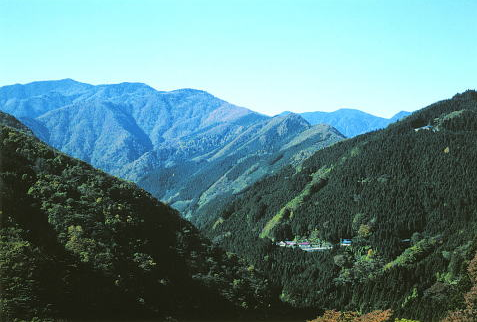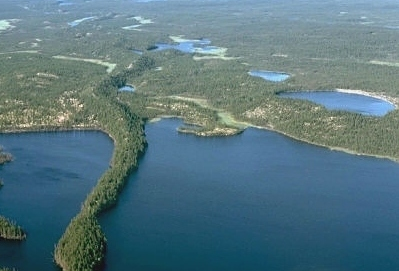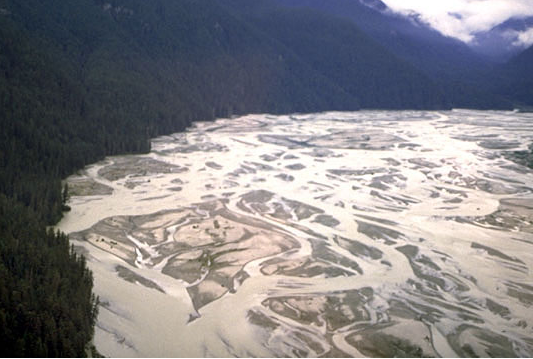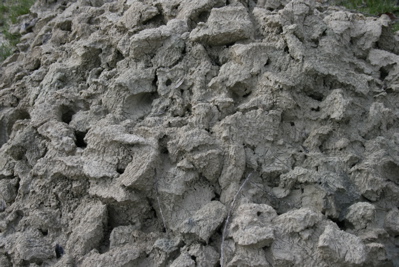Changes in Earth's Climate
The Earth's climate has changed dramatically and repeatedly over time. The past several million years was a time of relatively cool climate. Around 2 million years ago, the earth’s climate had cooled off enough that huge ice sheets, known as continental glaciers, formed in northern Canada. Because it was cooler, the ice sheets did not melt back during the summer, and each winter got bigger and thicker. Finally, the ice at the bottom of the ice sheets started to flow south. These glaciers advanced and retreated repeatedly over New England.
Map showing the extent of the most recent ice sheets to have covered North America
Carving the Earth
With each advance they scoured the surface of the earth, plucking up debris ranging in size from boulders to dust. During the Ice Age, glacial ice deepened and widened valleys, wore down peaks, and removed surface soils.
Questions to Explore:
What is it in the glacier that actually does the "carving" of the rock beneath the glacier? To answer this question, you'll need to answer this one first: what does glacial ice consist of, and how is this different from the clean pure ice in your freezer? If the glacier was simply one giant ice cube, it would not be able to destroy rocks to the same extent that glacial ice can. Why not?
How is it possible that ice can alter the landscape to such a large extent? Can you explain how entire mountains can be ground down simply by moving ice? How about valleys being scooped out by the same ice? Can you think of a way to explain this process? Could you come up with a model to show how this might be possible?

A typical v-shaped valley caused by water erosion (such as by a river running through it).

A u-shaped valley created by glacial scouring of a pre-existing v-shaped valley.
What the Ice Left Behind
The ice sheets advanced and retreated several times between about 2 million years ago and about 16,000 ago. The glaciers reached their maximum extent (for the last time) around 22,000-25,000 years ago. By about 16,000 years ago, the Boston area was finally free of glacial ice. When the glaciers retreated, they left hundreds of tons of debris in the deep valleys they had created, as well has deposits on the surface.
As the leading edges of the glaciers reached warmer climates and melted, huge meltwater rivers loaded with glacial clays, muds and sands flowed away from the edges.
At times the entire area of Massachusetts was covered by ice several thousand feet thick! When the ice sheets finally melted for the last time about 10,000 years ago, they left behind huge piles of this broken rock (we call them "hills"). Many of the hills of New England are simply piles of gravel and sand left behind by these ice sheets. There are different names for the different types of hills based on the way they were formed (such as drumlin, esker, kame, moraine).
This photograph, from a present-day glacier, shows how glaciers carry rock debris and how this debris gets deposited at the glaciers' edges.
Click on this picture to see more details about various glacial features and how they are created.
Questions to Explore:
How might you explain that large piles of rock, gravel and sand can be the result of moving ice?

A drumlin.

An Esker.
Question to Explore:
Look at the two pictures below. Both are eskers, but the material that makes them up is quite different. Can you describe the conditions under which these two eskers formed that might lead to their differences?


Question to Explore:
Look carefully at the details in the two pictures below. Which do you think was deposited more recently? What is your reasoning?


Changing Sea Levels and the Formation of Boston "Blue Clay"
During periods of advancing ice, so much water was locked into the glaciers that sea levels fell considerably, sometimes as much as several hundred feet. As they retreated, the water from the melting ice caused sea levels to rise again.
But that was not the only change. The weight of all that ice was so great that the surface of the land was actually pushed down below it....think of a heavily loaded ship riding low in the water and you get the idea. When the ice melted and retreated, the land, freed of this excess weight, slowly rose back up again.
So, in the Boston area, sea level is an ever-changing entity, geologically speaking. As the last major ice sheet retreated, about 15,000 years ago, the land rebounded and sea level was higher than it is now. Huge amounts of debris were being deposited. Most of the sand and gravel was left near the edge of the glacier, but the lighter material, rock dust and clays, were carried into the oceans by melting water, and settled at the bottom. This “rock flour”, as it is known, became the Boston blue clay, which forms a thick layer under almost all of Boston and Boston Harbor.
The glacier had a short readvance about 12,200-11,600 years ago. This pushed some of the blue clay deposit into a low ridge, which formed the neck which later became the only connection from the Shawmut Peninsula to the mainland. After that, the glacier retreated. We are currently in an interglacial period.
As the glacier retreated, the land slowly rose. This resulted in the land that became Boston Harbor actually being above sea level. At this point, the Boston Harbor Islands were not islands at all, but could be accessed by land.
Over time, the rebound slowed, sea levels from melting glaciers kept rising, and the hills in the harbor became the Boston Harbor Islands.

An outwash plain at the end of a glacier. The sediments contained in this mud are similar to those deposited by the New England Ice sheets, which now underlies much of Boston as the "Boston Blue Clay".
Glacial Clay, similar to the Boston Blue Clay




